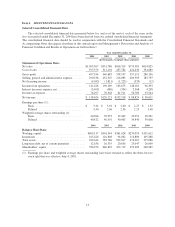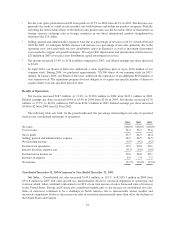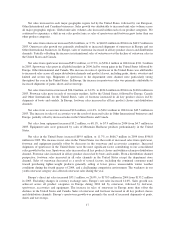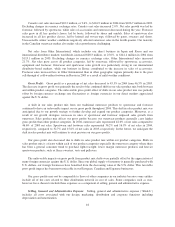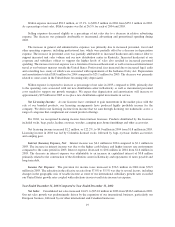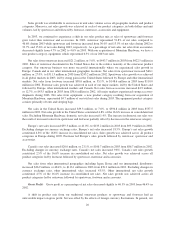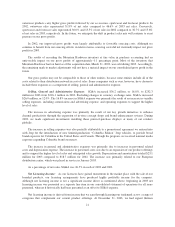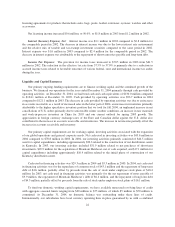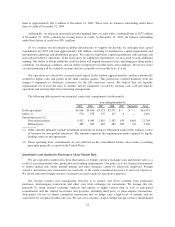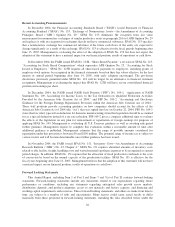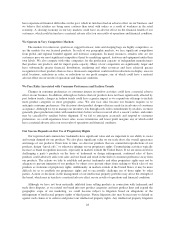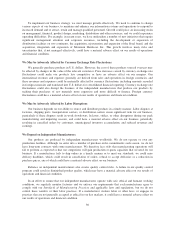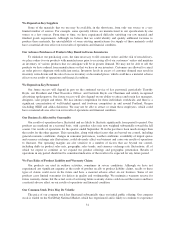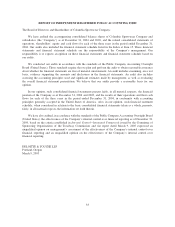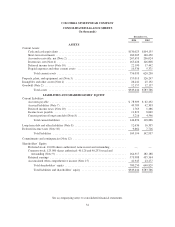Columbia Sportswear 2004 Annual Report Download - page 29
Download and view the complete annual report
Please find page 29 of the 2004 Columbia Sportswear annual report below. You can navigate through the pages in the report by either clicking on the pages listed below, or by using the keyword search tool below to find specific information within the annual report.payments related to intercompany loan agreements. Hedged transactions are denominated primarily in the Euro,
Japanese yen and Canadian dollars.
The fair value of our hedging contracts was unfavorable by $5.0 million and $2.8 million at December 31,
2004 and 2003, respectively. A 10% change in the Euro, Japanese yen and Canadian dollar exchange rates would
have resulted in the fair value fluctuating approximately $8.1 million at December 31, 2004 and $7.0 million at
December 31, 2003. Changes in fair value, resulting from foreign exchange rate fluctuations, would be
substantially offset by the change in value of the underlying hedged transactions.
Our exposure to market risk for changes in interest rates relates primarily to our debt obligations. We have
no exposure due to interest rate changes on our $12.6 million and $16.3 million of long-term debt at December
31, 2004 and 2003, respectively. We do, however, have cash flow exposure on our committed and uncommitted
bank lines of credit because interest on those lines floats and is based on LIBOR and other interest rate indices.
Critical Accounting Policies and Estimates
Management’s discussion and analysis of our financial condition and results of operations are based on our
consolidated financial statements, which have been prepared in accordance with accounting principles generally
accepted in the United States. The preparation of these financial statements requires us to make various estimates
and judgments that affect reported amounts of assets, liabilities, sales, cost of sales and expenses and related
disclosure of contingent assets and liabilities. We believe that the estimates, assumptions and judgments involved
in the accounting policies described below have the greatest potential impact on our financial statements, so we
consider these to be our critical accounting policies and estimates. Because of the uncertainty inherent in these
matters, actual results could differ from the estimates we use in applying the critical accounting policies. We base
our ongoing estimates on historical experience and other various assumptions that we believe to be reasonable
under the circumstances. Many of these critical accounting policies affect working capital account balances,
including the policy for revenue recognition, the allowance for uncollectible accounts receivable, the provision
for potential excess, close-out and slow moving inventory, product warranty and income taxes.
Management and our independent auditors regularly discuss with our audit committee each of our critical
accounting estimates and the development and selection of these accounting estimates and the disclosure about
each estimate in Management’s Discussion and Analysis of Financial Condition and Results of Operations. These
discussions typically occur at our quarterly audit committee meetings and include the basis and methodology
used in developing and selecting these estimates; the trends in and amounts of these estimates; specific matters
affecting the amount of and changes in these estimates, and any other relevant matters related to these estimates,
including significant issues concerning accounting principles and financial statement presentation.
Revenue Recognition
We record wholesale and licensed product revenues when title passes and the risks and rewards of
ownership have passed to the customer, based on the terms of sale. Title generally passes upon shipment or upon
receipt by the customer depending on the country of the sale and the agreement with the customer. Retail store
revenues are recorded at the time of sale.
In some countries outside of the United States, predominantly where we sell directly in Western Europe,
precise information regarding the date of receipt by the customer is not readily available. In these cases, we
estimate the date of receipt by the customer based on historical and expected delivery times by geographic
location. We periodically test the accuracy of these estimates based on actual transactions. Delivery times vary
by geographic location, generally from one to four days. To date, we have found these estimates to be materially
accurate.
Upon shipment, we also provide for estimated sales returns and miscellaneous claims from customers as
reductions to revenues. The estimates are based on historical rates of product returns and claims that have ranged
24


